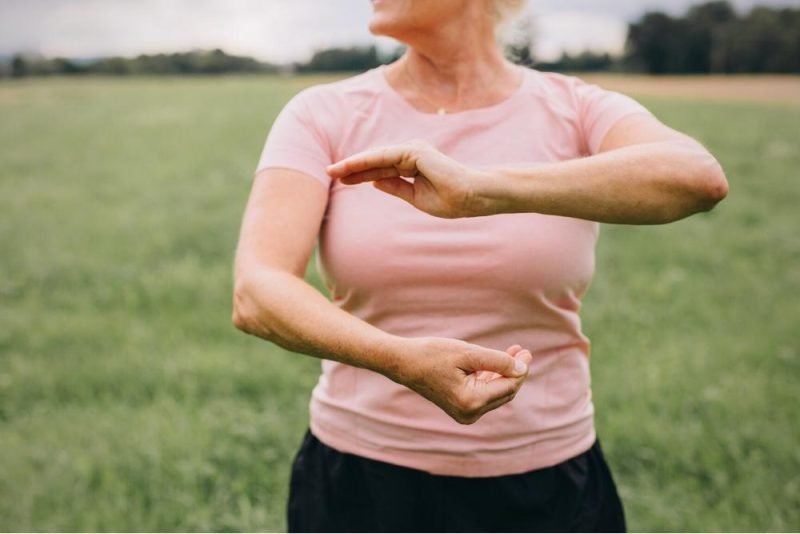
Did you know your head and your body are connected? No, really…they aren’t separated at the neck! OK, I’m being a little flippant there, but let’s face it, many of us do walk around as if there was a gap above our collarbones, at least some of the time.
If you want to talk physiology, our brains and our bodies are in constant two-way communication. That ensures that essential-to-life functions like breathing and circulation happen 24-7. This communication also affects the state of your nervous system – whether you’re in fight, flight, freeze, please or (ideally) rest mode. And, because most of the mood-boosting chemical serotonin is produced in your intestines, the health of your gut definitely affects the state of your brain.
And those are just a few examples. A strong mind-body connection helps us care for our health and well-being in countless ways.
But it’s not unusual to be all up in our heads, caught up in our thoughts, our worries, our anxieties. Our brains can spin the most doomsday, no-happy-endings-here stories about the state of the country, the world, our relationships, our bodies. Oh yeah…what about your body? How do you get into it?

Stop and smell the roses
Whether you’re a worrier, a planner, or are just too busy, when you spend most of your time lost in your thoughts, your experience of life gets short shrift. Because when you’re thinking, you aren’t noticing and experiencing the present moment. You aren’t mindful.
Of course, to get out of your head, you have to be aware of when you’re stuck there, replaying past events or rehearsing future scenarios. But, how you do that? We’ve already established that when you’re caught up in thoughts, you aren’t very aware.
You could simply seize the moment when you do happen to notice you’re in your head and pretty much oblivious to the world around you. You can also set external reminders (alarms, phone notifications) prompting you to stop what you are doing (and thinking) and drop down into your body.
The two ways I like to do this are to get grounded or to do a body scan. When you “ground” yourself, you turn your attention to the places where your body contacts surfaces.
- Your feet on the floor
- Your butt and the back of your thighs in a chair
- The back of your body on the floor or bed
These become proxies for the ground, or earth. Hence “grounding.” (Doing a slow barefoot walking meditation outside on grass or other safe surfaces can be a lovely, and literal, grounding exercise. You could also stand, sit or lay in the grass.)
There are various forms of body scans, but they essentially boil down to placing your attention one body part at a time, starting at the head or the toes (your choice), and note what you feel there. Tension? Tingling? Energy? Tightness? Softness? Contraction? Expansiveness? Warmth?

A brief note about trauma
If you have a history of physical or sexual trauma, or if you have endured a lot of verbal abuse directed at your body, then your body might not feel like a safe place to be. You may not want to drop down into your body via a body scan. In fact it might not be a good idea for you to do so without professional guidance from a trauma or somatic therapist.
Generally, grounding exercises are safe and beneficial for trauma survivors, because you’re simply connecting with the physical world. As mentioned above, this can take the form of turning your attention to the feel of your feet on the floor or your butt in the chair. You can also turn your attention, and your senses, to the world around you. You can look at, and name, objects, textures or colors. You can notice and name smells or sounds.
Walking can also be a grounding exercise (provided you are able to walk). You can notice your feet striking the ground, the feel of the breeze or sun on your skin, the sounds of birds or rustling leaves.

Why it’s worth slowing your roll
Are you rushing all the time? If so, you’re probably thinking, and not experiencing your body and its surroundings. I broke my little toe this way several years ago, rushing out of my bedroom to…I don’t even remember why…and stubbing my toe on one of the wooden bed posts. I sure experienced my body then!
When you move more slowly, you notice more. I put a halt to power walking while sightseeing on vacation a few years after the broken toe incident, because I wanted to SEE things, not just race from point A to point B. (This was in Hawaii, no less, which is a perfect place to slow your pace.) Slowing down when I fold fitted sheets makes the process more satisfying, less frustrating .(I have the technique down, but it goes more smoothly when done slowly.)
Slowing down can be formal or informal. Tai chi, which involves slow, conscious movement along with deep breathing is one formal practice, and research shows that people who do practice it are less likely to experience stress, anxiety or depression. For now, one of my informal practices is to walk through my garden daily (even if I’m not actually gardening) to admire and check in on each plant.
Another informal slow-down practice is to mindfully shower or bathe (this can also be grounding, because water is a natural element). I will admit that I do some of my best thinking in the shower, but sometimes I intentionally pay attention to how the water feels on my skin. You can also turn it into a nice work-to-home transition by visualizing the stresses of the day washing or soaking away.

Interoceptive awareness
One key element of Intuitive Eating is interoceptive awareness. This includes the ability to notice internal cues of hunger and fullness, but it’s so much more than that – it’s about perceiving all manner of internal states and sensations. A full bladder. A “gut feeling” about someone. A racing heart. Plus, any of the sensations (and more) that I mentioned above when talking about body scans.
That last bit is important, because while thoughts are in our head, emotions are felt, experienced and stored in our bodies. Different emotions activate different parts of the body. One of my “tells” for when I’ve been experiencing low-level stress for a period of time (often when I have a lot of several deadlines in rapid succession) is that my upper back will become very tense. Often, that’s what I notice first, then I realize, “Oh yeah…the last few weeks have been stressful!” Then I prioritize fitting in some meaningful self-care.
We can’t tend to our emotions if we don’t notice them. Being aware of body sensations associated with emotions does more than tell us that we’re feeling something, it can help us identify what emotion we’re feeling. I thought this article on Greatist discussed this idea nicely.
When we can identify our emotions, we can then either make room for them to fade, or take action to lessen their intensity more quickly. To echo what I discussed about trauma above, if it doesn’t feel safe to be in your body, then tuning into how emotions feel in the body won’t feel safe either.
Similarly, people who are neurodivergent (ADHD, autism spectrum disorder, or a number of other conditions) may have trouble with interoception. That can also be true for neurotypical people who have just spent a LOT of time in their heads, although they can usually improve interoceptive skills if they so choose.
Carrie Dennett, MPH, RDN, is a Pacific Northwest-based registered dietitian nutritionist, journalist, intuitive eating counselor, author, and speaker. Her superpowers include busting nutrition myths and empowering women and men to feel better in their bodies and make food choices that support pleasure, nutrition and health. This post is for informational purposes only and does not constitute individualized nutrition or medical advice.
Seeking 1-on-1 nutrition counseling? Learn more about her Food & Body, IBS management, and nutrition counseling programs, and book an intro call to see if the program is a good fit, and if we’re a good fit!
Want exclusive content on nutrition, health, diet culture and more, plus critiques of nutrition and health journalism? Subscribe to my Food Noise newsletter! 📣
[print_link]






